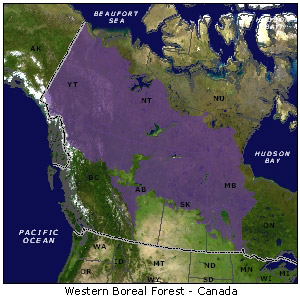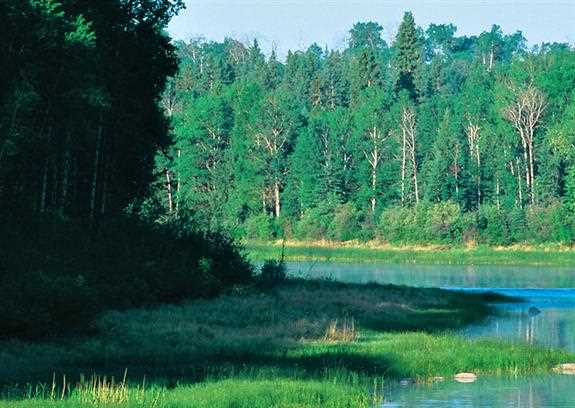The Canadian section of the Western Boreal Forest, a central breeding ground for many duck species and one of DU's conservation initiatives
The boreal forest is the world's largest land-based ecosystem. In Canada, it covers two-thirds of the country. At least 20 percent of the boreal forest is comprised of wetlands, and millions of ducks breed in this vast, largely unspoiled region. In some years, this amounts to about 40 percent of the continental duck population.
Millions of other migratory waterbirds and billions of landbirds also use the Western Boreal Forest (WBF). However, human impact on this area is increasing. The WBF is ranked No. 3 of the 25 most important and threatened waterfowl habitats on the continent.


Western Canada and Central Alaska are part of one of the largest forested regions in the world. A particularly important and distinctive portion, hereafter referred to as the Western Boreal Forest (WBF) is at the heart of this ecosystem and covers >3 million km2. In addition to vast timber reserves, this region encompasses thousands of km2 of lakes and wetlands providing critical breeding, staging and molting habitats for North American waterfowl and waterbirds.
The eight ecozones that comprise the WBF contain a mosaic of wetland complexes, meandering river valley flood plains and some of the largest inland river deltas in the world. Spruce, pine and fir dominate much of the uplands along with mixed-wood forests of aspen, birch and poplar. Forest fire historically has been the dominant rejuvenating force influencing upland and wetland vegetation structure. Beavers also influence wetland abundance and function.
The WBF annually supports breeding populations of 12-14 million ducks (Table 1). Scaup, mallard, American wigeon, green-winged teal and scoters each have breeding populations between 1 and 4 million birds. Boreal lakes, fens and bogs also are primary breeding areas for common loons, sandhill cranes and red-necked grebes. Several species of shorebirds, including greater and lesser yellowlegs, short-billed dowitchers, spotted and solitary sandpipers and Wilson's phalaropes, use boreal wetlands for breeding. At least two bird species of special interest, the trumpeter swan and whooping crane depend almost exclusively upon boreal wetlands for breeding. Riparian and wetland habitats also are important for nesting and foraging for many passerine species.
The permanent water provided by boreal wetlands and lakes is important to millions of molting waterfowl from the parklands and prairies to the south. During spring and fall migration, northern-breeding waterfowl also congregate on these lakes.
Boreal wetlands have been considered stable and largely undisturbed because of their remoteness, and thus management of boreal wetlands has been viewed as expensive and unnecessary. This situation is changing. The WBF, though vast and difficult to access, is undergoing rapid transformation from undisturbed wilderness to a resource-rich, commercially exploited region. Wetlands systems are being impacted by forest cover removal, climate change and extensive linear developments (e.g., roads, seismic lines). Five environmental pressures predominate:
Since the glaciers receded, fire has been the most dominant recurring event affecting natural processes in the boreal forest. In this region, the effects of fires on aquatic systems are not well understood, but are likely to be important. Intensive fire suppression and forest harvesting are changing historical disturbance regimes.
In the last 30 years, commercial forestry has increased dramatically in the WBF. Governments have encouraged development by granting cutting rights to vast areas of forest. Forest Management Agreements and other licenses provide exclusive access to Crown Lands for large forestry companies, typically for tenures of 10 to 20 years in Canada, and up to 50 years in Alaska. Recent technological improvements in harvesting methods, road building, and the use of aspen for pulp production have enabled timber harvest to increase dramatically. The vast majority of the commercially valuable timberland in the central WBF has been allocated and scheduled for harvest over the next 40 years.
Extraction of petroleum resources is the primary threat to boreal habitats where little marketable timber is present. The fourth largest oil field in Canada is located at the heart of the taiga plain at Norman Wells, NT. Alberta, however, possesses the bulk of the region's oil and gas fields. There are over 88,000 well sites located in Alberta's portion of the boreal forest alone, and >885 km2 have been cleared for those well sites. Between 1986 and 1995, approximately 500,000 km of seismic lines were approved to be cleared in Alberta, and by 1998, more hectares of land were cleared each year for oil and gas pipelines, seismic lines, roads and well sites than were cleared by forest logging. Although most of this activity is in the south central portion of the WBF, these combined impacts illustrate the level of fragmentation that can occur in more remote regions if they contain extractable minerals. In addition to land clearing, petroleum production and oil sands mining promote a high degree of habitat fragmentation, hydrologic interruption, and air and water pollution.
Land clearing, followed by wetland loss, has been especially rapid in the forest's southernmost region as a result of agricultural expansion. The aspen parkland transition zone and the Peace Parklands have been hardest hit, and present-day conversion rates are likely to increase with growing human populations and a warming climate. In the Alberta parklands, some 200 km2 per year were converted from forest cover to agriculture from 1949 to1995, mostly for small grain crops and improved pasture. Government-owned forestland located on soils suitable for agriculture continues to be sold to farmers for conversion, and the agricultural industry has targeted the WBF for accelerated expansion.
The character of the boreal zone is partly determined by long, cold winters and short summers. Temperatures in central Canada already have warmed at a higher rate than in most of North America. With a doubling of atmospheric CO2 in the next century, average temperatures in the WBF may increase by as much as 4.20 C. This is expected to result in drier average conditions, greater annual climatic variation, melting permafrost, altered surficial hydrology and higher rates of wildfires. Vegetation zones are likely to shift slowly northward and up to 16 million ha of new ground may become suitable for agricultural production. Significant changes in wetland ecology, including food webs that support duck populations, are likely but cannot be predicted with certainty.
Dams for power projects already have altered the hydrology of major boreal wetland systems, most notably the Peace-Athabasca Delta near the Alberta/NT border and the Saskatchewan River Delta on the Manitoba/Saskatchewan border. Many other projects are on the drawing boards. Today, more hydropower projects are proposed for Alaska than for all other states combined. The proposed Rampart Canyon Dam (now on hold) would have caused the inundation of nearly 27,000 km2 of the Yukon Flats.
With the exception of a number of isolated studies, very little is known regarding the ecology of wetlands and waterbirds in the WBF. High priority information needs include the identification and description of key habitats, the relative value of these habitats to continental waterbird populations, and the ecological processes affecting habitat productivity. DU's current activities are focused on land cover inventory and mapping, waterbird surveys and wetland productivity research, all of which need to be expanded in the future. DU's actions over the past 2 years have stimulated partnership opportunities with industry, government agencies, universities, and aboriginal groups and greatly enhanced the understanding and concern for wetland systems in the WBF.
Over the next 20 years DUC will work to maintain the WBF as a landscape including wetlands and adjacent uplands capable of supporting waterfowl populations at levels comparable to the 1970s. By initiating actions to preserve the ecological integrity of wetlands and critical uplands, DU will be viewed as a leader in the conservation of habitat for waterfowl and other wetland wildlife in the WBF. Although the primary focus of DU activities will be the protection of intact wetland systems that support waterfowl and other wetland wildlife, restoration of damaged systems will be undertaken through innovative policies, land use practices, and partnership developments.
Future land use activities in the WBF will respect the functions and values of wetlands in the sustainable development of the region. By working with industry, government, and aboriginal partners with interests in the WBF, we will significantly increase our understanding of WBF wetlands, their values for waterfowl and other wildlife and the impacts of various industrial activities on the productivity of these wetlands. This information will be used to increase societal awareness of the values of the WBF to wildlife and to promote sustainable land use policies and practices that will maintain the ecological integrity of the region. As a result of DU's efforts, the WBF will continue to play a significant role for North American waterfowl.
Ducks Unlimited uses cookies to enhance your browsing experience, optimize site functionality, analyze traffic, and deliver personalized advertising through third parties. By continuing to use this site, you agree to our use of cookies. View Privacy Policy